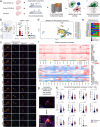High throughput spatial immune mapping reveals an innate immune scar in post-COVID-19 brains
- PMID: 39060438
- PMCID: PMC11281987
- DOI: 10.1007/s00401-024-02770-6
High throughput spatial immune mapping reveals an innate immune scar in post-COVID-19 brains
Abstract
The underlying pathogenesis of neurological sequelae in post-COVID-19 patients remains unclear. Here, we used multidimensional spatial immune phenotyping and machine learning methods on brains from initial COVID-19 survivors to identify the biological correlate associated with previous SARS-CoV-2 challenge. Compared to healthy controls, individuals with post-COVID-19 revealed a high percentage of TMEM119+P2RY12+CD68+Iba1+HLA-DR+CD11c+SCAMP2+ microglia assembled in prototypical cellular nodules. In contrast to acute SARS-CoV-2 cases, the frequency of CD8+ parenchymal T cells was reduced, suggesting an immune shift toward innate immune activation that may contribute to neurological alterations in post-COVID-19 patients.
Keywords: COVID-19; Imaging mass cytometry; Long-COVID; Microglia; Neuro-long-COVID-19; PACS; PCC; Post-COVID condition; Post-acute COVID syndrome; SARS-CoV-2.
© 2024. The Author(s).
Conflict of interest statement
The authors declare no competing interests.
Figures


References
Publication types
MeSH terms
LinkOut - more resources
Full Text Sources
Medical
Research Materials
Miscellaneous

